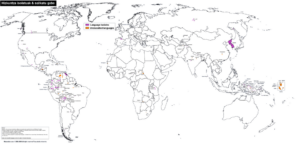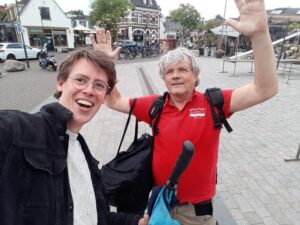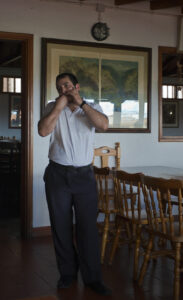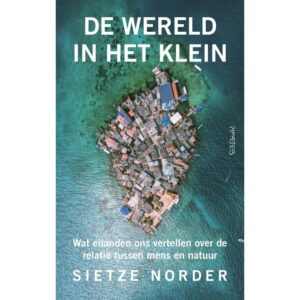As a co-author of a recently published article on languages on islands, I was delighted to learn that there was a biologist who had written a book on islands in which he also wrote something about languages. The author of the book is called Sietze Norder.
I was even more delighted to learn that this researcher was now part of the research group of linguist Rik “Enrique” van Gijn in Leiden. At the end of the 1990s, Rik van Gijn was in Aarhus for half a year to write his thesis on the sound systems of mixed languages, for which he had sought my expertise. Van Gijn is now working at the University of Leiden on the languages of South America. About 600 languages are spoken in this continent from about 112 different language groups or families. Of those, a staggering 62 of those are families of only one language. Orphans really, or the hermits of languages. Families of one language are called isolates, that is, languages that are not related to any other language on earth. At least not provable. 62 isolates, that is a high number. Half of the world’s known isolates are, or have been, spoken in South America.
The word “isolate” of course has the same root as Latin insula, Italian isola, French îsle, English isle, and also insular and isolation. A biologist who understands islands would then seem ideal for a position as researcher of the distribution of language isolates.
Incidentally, Norder studied social geography for his interest in people, and earth sciences (geology) because of his interest in the physical world. One study for human interaction, the other for nature. That way, by combining those studies, you learn a lot about the people and their environments. He wanted to know what the connection was between humans and nature. And then you automatically end up with ecosystems and biology. In short, a truly interdisciplinary approach.
In short, a good reason to purchase the book about islands. And to see what he writes about languages and islands. The first bookshop in the Netherlands that I entered had it in stock. On my way to Denmark, heading home after my holiday, I managed to make an appointment with the author, and we speculated about islands and their languages.

Last year we published an article (Norder was not aware of it when he wrote the book) that is based on a workshop on island languages that was held at AIAS (Aarhus Institute for Advanced Studies) at the initiative of Joshua Nash (now: University or New England, Australia) and me. There were specialists in a dozen languages spoken on islands and archipelagos. One of the findings in the article was that virtually no isolates are spoken on islands. Only on Papua/Papua New Guinea, but that island is so large and so mountainous that the presence of countless language families and dozens of isolates there is hardly a surprise. Moreover, it has been populated for 45,000 years.
One could assume that islands are isolated, and their isolation could stimulate language changes that would lead to a language whose affinity can no longer be proven. However, that does not appear to be the case. We concluded in our article that languages on islands run a higher risk to be replaced by a new language. The original Berber language of the Canary Islands died out completely within a few centuries after the invasion of the Spaniards. The original languages of the Antilles have all disappeared, some after only a few years after European colonization, as a result of genocide by the British and French, others after a few decades as a result of colonialism, forced migration and abuse of power and slavery, and some more because of diseases that the Indians could not withstand. The native languages of the Amerindians of the Antillean islands all died out within a few centuries, except for one language of people who emigrated to the mainland (Garifuna). The imported languages of the enslaved Africans did not survive on the islands either. Those are all gone in the New World.
Most isolates are therefore not spoken on isolas, but in the interior of continents. In rainforests and mountain slopes. Not necessarily isolated areas. Not many along coastal areas either.

During my pleasant conversation with Sietze Norder we actually concluded that the time dimension also could play a role. The islands of the Atlantic Ocean have only been inhabited for a few millennia, most islands of the Indian Ocean for only a few hundred years, and many islands in Polynesia for about a thousand years. That is not a long time. Dialects can become so different after about 500 years that they can no longer be understood by others, and must be regarded as independent languages. Languages can develop further to such an extent that they are no longer recognizable at some point. Then one can no longer verify that they were ever related to another language, because they have changed so much over time. If languages no longer resemble any other language, then we consider them as an isolate.
Linguists can reconstruct language families as far back as six to ten thousand years ago. We can therefore conclude that the kinship of languages can no longer be established after so many millennia. Linguists often compare mostly words, but even the most stable words can be replaced by new words, and after so much time there are no words left that can help establish kinship. Then there are so few original words left with the same meaning, that there is no longer any basis for assuming a relationship, because it may just as well be a coincidence that they have words in common. In short, it takes a maximum of six to then millennia for an isolate to form. In reality closer to six thousand years. This also means that once an island was settled more than 6,000 years ago, its affiliation with other mainland languages (if they are not already extinct) can no longer be determined. The only islands that have been populated for this long, show enormous linguistic diversity, such as Papua New Guinea with 800 languages out of a population of just over two million in 1960. The country with the highest language density in the world is the Vanuatu archipelago, with 138 languages with an average of 2,200 speakers. Nearly 300,000 people live there. The languages all belong to the Polynesian branch of the Austronesian language family and they therefore related to each other. But the languages are often unintelligible to speakers of other languages of the archipelago. Archaeological research tells us that the islands were colonized 3,000 years ago. That’s not enough to create isolates, and this country’s data confirms that.

Well, we digress. What does Sietze Norder say in his book on languages? He has a section about the Silbo Gomero language of the Canary Islands. The special thing about this language is that it is not spoken or expressed with gestures, but whistled. It is one of several dozen whistled languages in the world. However, unlike the sign languages of the world, this whistle language is not an independent language, but in fact a whistled form of the local Spanish. So it is more related to Spanish as written Spanish or Spanish in Morse code, but produced in yet another way, namely by whistling. As mentioned above, the original African Berber language has long since disappeared from the island, and the native Guanches are believed to have been able to whistle their language as well. After all, these islands are called the Canary Islands. Whistled languages are mainly used in mountainous regions: Turkey, Greece, Mexico. Whistling carries much further than talking or yelling, so in that way you can communicate with someone standing on the opposite slope: “Juan, come home, your paella lunch is ready!”. The author claims that in this way one could communicate up to five kilometers away. Here the writer must be corrected, but it is not the author’s fault, it is often claimed and he has copied it. When you whistle something, it takes 15 seconds for the sound to travel over five kilometers. The answer also takes 15 seconds. The sound is also significantly distorted by the Doppler effect. People don’t wait that long for a scrambled statement. This is simply unrealistic, and not even achievable under ideal conditions, such as on open water on a perfectly windless day.
However, most of the comments on language in the book deal with the degree of extinction. The author mentions that in the past 500 years, 300 of the world’s 7,000 or 8,000 languages have become extinct. As a linguist you immediately think: only 300??? Only four percent??? He may be right, but virtually all 300 Australian languages are on the brink of death, 400 languages in North America and South America are also in alarming decline. So the great extinction of languages is yet to come. Pessimistic yet realistic estimates say that by the end of this century there will be only around 70 languages left on Earth, and that 90% of today’s linguistic diversity will be gone forever. 27 percent of the remaining languages are spoken on an island.

As far as animals are concerned, it is mathematically in line with the expectation that 10 species (plants, animals) will become extinct every year. Under normal circumstances. That’s how it used to be, during the Quaternary. But due to one species, Homo sapiens, the extinction takes place a hundred times, possibly a thousand times faster than it should be.
People are threats to life on earth. For each other and for other animals. Sixty percent of the extinct species thus far were animals and plants that were only found on islands, although islands make up only about seven percent of the world’s land mass.
Sietze Norder’s engaged book opens our eyes to the fragility of ecosystems, and sideways to the dilapidated state of the world’s languages.
The book is written in Dutch. Clear language, hats off. It is very accessible. I understand that an Italian translation is underway, and that negotiations are underway for several other languages, including English. Here is some information in English about the book.
In short, things are going badly for the languages of the world, with languishing biodiversity and linguistic biodiversity. Damn bad, actually.
https://sietzenorder.nl/media/
https://sietzenorder.nl/en/sietze-norder-2/

Verder lezen, het genoemde artikel over talen op eilanden:
Nash, Joshua, Peter Bakker, Kristoffer Friis Bøegh, Aymeric Daval-Markussen, Hartmut Haberland, Dale Kedwards, Carsten Levisen, Jón Símon Markússon, John Ladhams, Joost Roger Robbe, Jeroen Willemsen 2020. On languages on islands. Acta Linguistica Hafniensia 52(1): 81-136.
Peter Bakker was born in the Netherlands on the island of Dordrecht and therefore learned to swim when he was five years old. He then learned languages and became a linguist at Aarhus University. He has written, among other things, about languages on islands.






